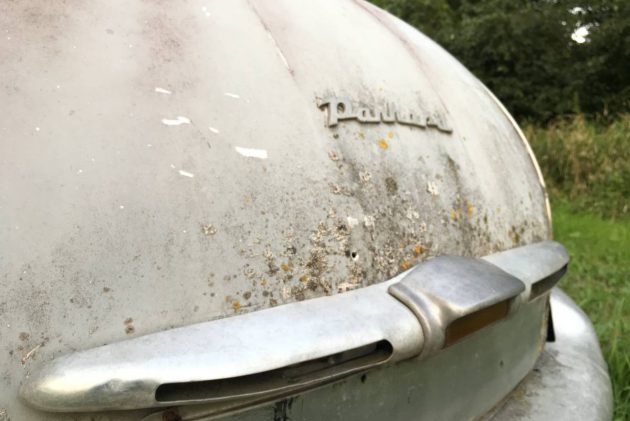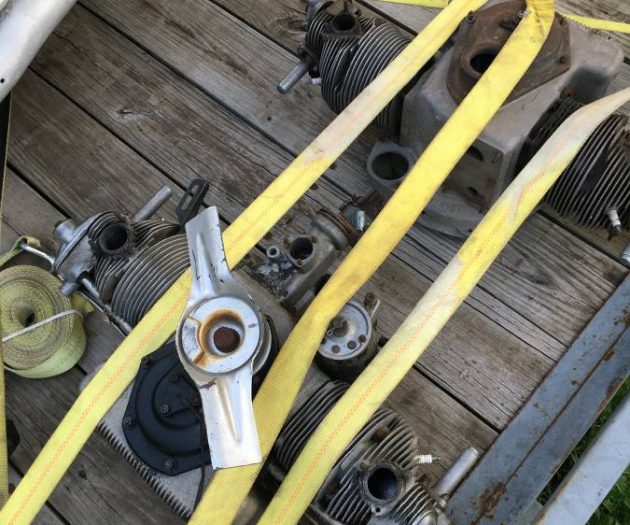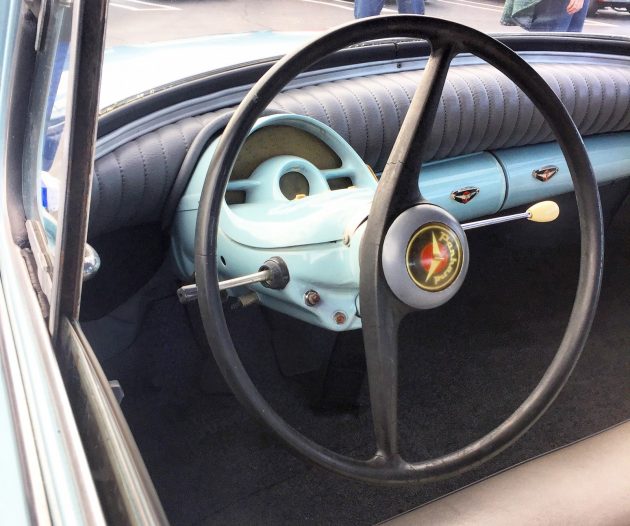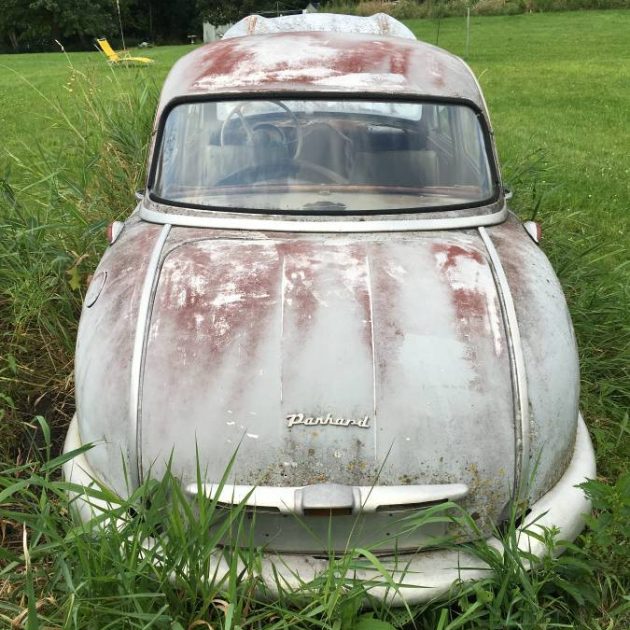If only it was a few years newer, I could make a “Tigre in the grass” joke…oh, well. I’ll give it up for a Panhard any time! This product of one of the world’s earliest automakers is ’56 Dyna Z, sent to us by our friend Dominic Ortiz, and while it’s being advertised on San Diego craigslist, we only know that it’s located in the “Midwest.” Good luck finding it—if, that is, you think it’s worth the $7,600 asking price (archived ad).
Our mysterious seller (who has a Minneapolis area code, so maybe that’s a clue to the car’s location; of course, simply calling the number would probably solve the mystery) is a person of few words, noting only: “Aluminum body. Comes with 2 extra motors. Car is complete, but needs restoration.” An aluminum body, which can corrode, but not rust, might make restoration sound easier, but it may be more complicated than that. While the Dyna Z did indeed have an all-aluminum body when it was introduced in 1954, production difficulties (or perhaps cost-cutting after Citroën took a 25% stake in Panhard in 1955) led to a switch to steel for fixed structural components, with only the doors, hood, and trunklid retaining the lighter material. The timing of this change is unclear, however; some sources indicate that it happened as late as 1958, while a September, 1956 road test in Road & Track mentions the switch, noting that the car’s weight had risen from 1,530 pounds (!) to 1,780. I’d go with the contemporary report and suggest that this Panhard likely is not all aluminum.
Here are the two extra engines mentioned in the ad, meaning that this is a six-cylinder Panhard! Yes, the Dyna Z was powered by an air-cooled horizontal twin of just 850 cubic centimeters, mounted ahead of the (driven) front wheels. This tiny powerplant was good for a surprisingly sprightly 50 horsepower; R&T recorded 0-60 in 23.7 seconds, better than a DKW 3=6, Volkswagen 1200, or Renault Dauphine tested the same year. At the same time, the compact packaging allowed interior space for six passengers with no drivetrain “hump” and reasonable hip and shoulder space thanks to its curvy body.
No photos are given of the interior, but it’s too cool not to show you; this is a slightly later PL-17 that I photographed at a cars and coffee meet earlier this year. I love the integration of the steering column, controls, and gauges into one sweeping pod. That’s a four-speed column shift, in true Continental fashion, and a nice safety pad, although your head is likely to encounter the windshield (which, to be fair, is designed to pop out) before that padding does you much good.
With a relatively solid overall appearance—although I’d be leery of how long this car has been sitting in that field—and some valuable extra parts, it seems like there’s a bit to work with if you want a unique project car. I’m still inclined to call the $7,600 price a bit ambitious, but there’s plenty of history and innovation baked into this little jewel. What do you think—is it worth combing the entire Midwest to find this one?








The French have really made some junk vehicles.
No actually, they’ve made some excellent innovative cars over the years.
I’d say, based on the pictures of it sitting on a trailer, it’s no longer in that particular patch of weeds. That’s as close as I can guess as to it’s whereabouts.
Panhard Lavassor is not just “one of the earliest car mfrs”, it is THE FIRST true car manufacturer, having won that accolade by completeing 26 cars during 1890 to the start of 1891. Check it out on Wikipedia. Better yet, order the recent well done book “Panhard – the flat twin cars from 1945-1967 and their origins” by David Beare of the UK. Very informative and humorous, it documents some extraordinary work on this little known marque.
Every hotrodder owes credit to this co. for inventing the Panhard rod for controlling their live rear axles.
And best of all, this all-rollerbearing engine, designed in ’45 to hit 7000 rpm, putting out a minimum of 40 hp from 850 ccs of hemi power, with roller lifters and hydraulically adjusted valves via floating rocker arms, has a conrod rollerbearing with two different diameter rollers designed by the master, Leonardo da Vinci – around 1480. How’s that for provenance? No other engine can claim that! How do I know? I saw Leonardo’s sketch in the archives of his last home in the Loire valley of France in 2005 – I damn near fell over!
These cars are not to be sneered at. I routinely drive my ’61 PL17 cabrio at 80 mph on the freeways around the Bay area. It tops out at 90, and loves to rev. My ’66 24BT coupe is good for 100. And 40 mpg is achievable, all with mid-50s French technology. They have their faults like all cars, but there’s lots to enjoy about their features. My ’63 PL17 wagon is shown below if the image works – just arrived by container this summer, & is the only one in N. America.
Great write-up namesake. I have been in the game for over 40 years and one thing is for certain, at 78 I still learn something new every day, and today I learned lots more. Thank you.
Can you post a photo of your 24BT? I´m sure most readers here would appreciate how good looking that car is.
I like all Panhard cars because they are likeable indeed! Your wagon looks fantastic and I know how cavernous they are, great design! Are you a member of the US Panhard Club?
Nathan,
You’re correct, this is a steel bodied car. The conversion began with the 1955 production year. The new chassis brackets and rubber engine mounts shown entered production in the Spring of 1955.
The French weight spec for the Dyna Z2 & Dyna Z3 (Luxe & Luxe Spéciale respectively) is 790 kg – 1738 lbs. An American spec car @ 1780 lbs per R &T must be spot on.
BTW the Dyna Parhard driven by Gillard & Dugat finished second in the 1955 Monte Carlo rally Behind the first place Sunbeam 90 with a Mercedes 220 third.
It’s amazing when one considers the other small displacement cars available in the mid 50s that this 850cc sedan had a top speed of 130 kph = 80 mph when 1200cc plus were finished at 65 – 70 mph.
Is this car worth $ 7600 (ono)? Not enough info for me to hazard a guess.
Ken, Great post and photo. Super! Saw it only after posting the above.
Car is absolutely not worth $7600, which will buy a good one in Europe. $2500 spent on shipping and import tax would not begin to restore this.
Mark, read Ken´s post, look at the Le Mans performance of DB and CD Panhards. These Panhards are brilliantly conceived and executed. Junk it ain´t, virtually a prototype for the future of light construction cars with improbably small but powerful motors.
I repeat. The French have historically made junk vehicles.
How about you take your blanket trolls to another site Mark? Thanks.
@Ken and James HGF, thank you kindly for sharing the info, I had no idea Da Vinci was behind the design of the engine, absolutely floored me.
Tips hat.
Mark, I would investigate the French auto industry before I would make such claims. True, the last 50 years have not been what I would write home about (but for the Citroen) but prior to that they made some of the most exquisite works of art that are called automobiles. The styling would SHOCK you.
Link to leboncoin.fr (French Craigslist more or less) private party:
https://www.leboncoin.fr/voitures/offres/centre/occasions/?o=1&q=panhard&f=p
About 40 of 68 vehicles listed are Panhards. I really like the ’52 Panhard Dyan X break which is mostly original with new retro interior @ 7500 € and the PL 17 pick up @ 12000€ (negotiable) which is fully restored.
Most ads have only 3 photos, but at least one has 10. Translate.google.com will kindly give one English text if requested.
There’s even a French V6 Rock Crawler listed @ 27000 €
Having worked with many of the world’s large car mfrs as a consultant for 30 yrs, I’ve learned that every name brand has made great cars at times, and junk cars at other times, simply because people in them have different and over time, changing conditions and goals that affect the product. Same goes for the purchaser. And having done all my own repair/restoration work for 60 yrs on every single brand I’ve owned and friend’s cars, I’ve seen a lot of stupid and brilliant engineering from the gritty, greasy inside – I go with the good points, and change the bad ones when I can. The purists don’t like me, but I respect their right to do what they want with their cars, and I’ll do what I want with my cars when i can improve serviceability/reliability. Different strokes for different folks.
PS:Not that I hate V8s (I own a ’64 Bristol 408 with Chrysler 313 V8 & Torqueflite pushbutton trans), but I love to pass modern cars on 880 and 101 around SF bay with only 2 cylinders, zero chips, and thumb my nose at the oil co’s by getting 40 mpg with ancient but clever technology that everyone else has forgotten.
Large format photo of Le Mans DB Panhard in the background of a Panhard Dolomite (yes, Dolomite) coupe that was manufactured in a small series by Carrosserie Pichon & Parat which built many unique cars and some limited production series.
http://www.encyclautomobile.fr/web/_encyclauto/cars/4351/x86_dolomite_pichon_parat_1954_bb.jpg
Pichon & Parat was Raymond Lowey’s favorite carrosserie. They built a unique BMW 507 coupe, a “customized” ’59 Caddy coupe for him and a secret Studebaker styling exercise that was a 2 door on “coupe-ish” the left side, but a 4 door on the right.
That Panhard Dolomite looks like the mid 50’s French Marathon. Any relationship? Years ago an old Panhard was frequently seen merrily scooting through the snow laden streets of Anchorage while most other vehicles were buried hubcap-deep in the snow.
James HGF, I checked out that ’52 Dyna X you found on Leboncoin – it is a dead ringer for my ’53 I imported three yrs ago – see pic. Bought it off Ebay.fr. It had been put in storage in ’69 and brought out in ’06, and someone had gotten it started. Only 24.5 K kilometers on it. Rebuilt the brakes on a trip to visit it, shipped it RoRo after that. Still had an ashtray full of Galoise cigarette butts, and a portable kerosene heater on the floor.
Only after i had bought a comprehensive repair manual did I find that the construction of these early cars used Gregoire’s approach of using huge aluminum castings to make the front half of the body! The entire firewall down the the kickplate and up to the windshield’s top frame is a single monster aluminum casting. The kickplate is another casting, along with all framing of the doors, the doors themselves, the hood, headlight nacelles and entire gastank. Mechanicals are mostly identical to the later 4 door Dyna and PL17 sedans.
Martin, you asked about the 24BT – see the Utube video we did at John McElroy’s studio in Michigan for his Autoline Detroit program: “Excuse me, but is that a Panhard in the studio?”. John’s program is always an inside look at the auto biz from all sorts of angles – he seems to know everyone worth knowing in the worldwide industry on a first name basis. I’ll see if I can also post a photo of the car – it’s a ’66, same basic engine but putting out 60 hp from same 850 ccs, good for 100 mph in the coupe.
Hi Ken,
Thanks for sharing a photo of your ’53 Dyna X – looks so good in its natural environment and likely super and surprising to virtually all in the bay area.
For some inexplicable reason my comment Sunday evening would not post. Multiple attempts failed. C’est la vie. Now back to the keyboard after a few days out of town.
The ’52 does sing a siren’s song for originality and location (Auxerre), but moteur bloqué not to mention a small variety of other machines (select one) on my summer 2018 hit parade leads me to be patient. Depending on the machine closed/open/cost RoRo is an intriguing choice.
Jean-Albert Grégoire said in 1947, “I don’t build cars! I research, I assemble, and I develop new prototypes. Any interested manufacturers can then either produce these prototypes in full, or adopt any devices they include.” He guarded his independence.
Among his creations are the CGE-Tudor of ’38 – ’39, ’40 – 42. A small good looking electric convertible that was battery powered. A couple have sold at auction in recent years – possibly one last year. Of course one must include his “Tracta-joint” design which pre-dates the CV joint, Tracta cars naturally and his various prototypes.
Some may be surprised that there was an English version of the AFG prototype of 1942 that is best known as the fore-runner to the Panhard Dyna X. That is the Grantham Productions Ltd, Grantham, Lincolnshire – Kendall with light alloy castings chassis (no surprise) and a 594cc flat twin. It looks very much like the ’42 prototype and was priced at 200 pounds Sterling. Very few were manufactured before the company collapsed. Bit of intrigue there.
Great info on these fascinating machines. I’ll vouch for the French making decent cars, having owned a few very satisfactory Peugeots.
French vehicles’ odd looks are justified by their unique and thoughtful engineering.
Outstanding post Barn Finds ! Plenty of shared informative knowledge with some great contributors. What great fun !
I SO wanted to call it ugly!!!!!! But I cannot!! It is actually a very cool looking, inside, outside, and under the hood vehicle. I have never heard nor seen of these, until today! I love the “Everday Something New” ideology!
Thank you BF and even more, thank you BF readers/information suppliers for supplying the “whole story” !!!
James, Gregoire’s prototype with flat twin is shown in David Beare’s history – terrific photos and explanations of what he proposed and which Panhard certainly patterned their engine after. The book is worth getting just for the historic background on these intriguing family cars manufactured for a country which had no oil, so needed frugal cars yet driven by owners who loved speed and had to deal with lousy roads in that era.
When I got my ex-Chrysler “China car” Dyna which Bob Lutz brought into Chf Chrysler engr. Francois Castaing’s cheap car program, I took it on a short backroads road rally with a bunch of car guys in the Ann Arbor area. They’d never seen one before, and they all had fast European and American cars which they drove hard on our twisty twolanes. When we stopped for lunch, someone asked me about the car’s engine. When I told him it had only two cylinders, he just about choked! I’d had no trouble keeping up with everyone even tho I lacked their acceleration. He then said I ought to have gotten a “driver of the day” award. That’s one of the best features of a Panhard – they surprise everyone. See Jay Leno’s recent video on his PL17 as he takes it on a drive with our club’s president, John Peterson of Reno. Jay has at least 3 different Panhards in his collection.
See the Hotchkiss-Gregoire below, shown in Carmel in 2016 – once owned by Ed Cole of GM, & recently restored by Alain Cerf of Fla. This has the Gregoire huge aluminum cockpit casting, supporting a FWD flat four Gregoire engine and is testimony to French engineering. Its front suspension consists of very long horizontal arms operating horizontal springs similar to racing rear suspensions – very unusual, and I believe a one-off.
1.There was someone near Greencastle, Ind had a bunch of Panhards ad I believe raced one.
2. I owned a Peugeot 504 diesel. Best and worst car I ever owned. The 505 turbo diesel 5 speed was a perfect car. More comfortable than a Town Car and great mileage. If French cars where built by Japanese companies they would be formidable competition.
That person might have been John Skene – I’d heard of him several times over the yrs – he did race the cars if it’s the same guy but that was a long time ago. A friend in NY State, near Niagara, has raced a blue Panhard Junior for many yrs – saw him first at the Pittsburg vintage races – the headlights were eyeballs and he’d added a big red felt tongue hanging out of the grille – he often shows up when racing Panhards are googled.
John Skene was my Grandfather. I was lucky enough to crew for him a few times at Road Atlanta and once at Sebring. He was one of the last real DB Panhard experts. I am crewing for my father Jay Stephenson #30 Cheetah currently.
I believe the 1956 Panhard dyna-z in the are of Minneapolis is for sale again, it is on Craigslist with a phone number of 612-296-4011, I am in Minneapolis so if you wanted someone to go take a look I could do that. My email [email protected]
….merci to all who contribute interesting info and comments about Panhard cars; best time of the day while sipping my morning brew.
For more info on Panhards, check out Jay Leno’s videos on BIG DOG GARAGE where he talks with our club president John Peterson. Jay now has at least 3 Panhards, and does a nice ride & drive on one with Peterson. And later this week, I’ll be doing a video on Autoline Detroit with John McElroy who regularly reports on the inside workings of the Detroit and worldwide auto scene. We’ll be reviewing the Chrysler CCV program from the ’90s, where a program attempted to develop a very low cost entry vehicle similar to a 2CV Citroen for the China market as it existed back then. The video will show a 1959 Dyna Z16 sedan that Chrysler Pres. Bob Lutz found and brought into the program back then as a study car for their 2 cylinder engined car.
I’m collecting this very 1955 Dyna Z1 and spare parts this weekend.
This is an early aluminum bodied car, not a later steel bodied car. The later chassis brackets and rubber engine mounts were used to fit a PL17 engine and transmission. The original aluminum hood has been replaced with a later steel hood, likely because the aluminum hoods were easily damaged.
Folks on the Facebook Panhard group seem quite friendly and readily share information.
Steve, where are you in the world? The two engines on the pallet are the early unshrouded ones, so one of these should be for this early Z1. Too bad the car doesn’t come with the ally hood – it’s a joy to lift when you have to work on the innards!
Your car should have the 400 mm rims, on steel/cast iron drums, so you’ll be looking for 145-400 Michelins for the wheels. You’ll also find another funny difference to the PLs – the Z1 drums are different – front vs rear, and the rears are narrower – at least they are on my ex Reynolds aluminum collection Z1. if you have any questions on these cars, feel free to contact me – I’m in Mich. now, but will be in Ca for the winter –
Ken
Since we’re talking Panhard…..FYI I know à source here in the US for cast aluminum finned drums for the CD …..I don’t suspect these would fit a PL? I am not a Panhard wizard, obviously.
Hey Ken. I live in Northern California but am stashing the Dyna Z1 at a friend’s place in Oklahoma for now. Where in California are you wintering?
I’m planning to install PL17 wheels and hubs as 145-400 tire selection is poor in the U.S., and the car has already been upgraded to other PL17 parts.
The car came with a lot of parts, including front and rear glass, the engines, a couple of transmissions, and other stuff I’ll have to identify and inventory.
Steve, I’m back near Ann Arbor Mich. for the fall, but move W to Palo Alto come December – too cold here for my fingers to work in the barn! Just hauled another PL17 here from Ohio – sill bottoms GONE, but car didn’t break in half on my 3 hr dolly tow home yesterday. Where in N Ca are you?
Don’t pitch the 400 mm suspension stuff, as I have several early cars with the oddball tires & might want to buy some of those parts off you. Going to the 15s is the smart thing to do – just swap out the whole kingpin/drum combo and plug in the later ones.
PS: best deal on 145-400 mm Michelins or any classic tire is Longstone Tire in the UK – better prices than Coker, and free delivery to US in a WEEK to your door or less! I have them on my 16 in. Bristol wheels, for two cars.
BTW, I’ve found some minispares that you could use if you’re near a PickNPull yard that can be installed on the drum hubs as rollers dirt cheap, plus have developed a lot of simple fixes for a lot of the Panhard or any oddball car ills. We have a few Panhards in the Bay area and a good Citroen club which welcomes the P cars.